 |
> E&O/GL Insurance for Home Inspectors Competitive Rates, Broad Coverage, Free Risk Management, online inspection support for tough questions, discounts on education and more... Professional Coverage, Competitive Pricing Shop OREP today! |
>> Editor’s Note: To help you stay up-to-date and connected, OREP/Working RE has established a Coronavirus (COVID-19) Discussion and Resource Page where you can share your thoughts, experiences, advice and challenges with fellow inspectors. See what Inspectors are saying here!
>> Take the Coronavirus: National Home Inspector’s Survey. Provide your industry feedback.
Fuel Oil Tanks
by Reuben Saltzman, Structure Tech
If you’re inspecting a house in the Twin Cities, or possibly elsewhere in the country, if there are pipes sticking up out of the ground in the yard, heads up. You may have a fuel oil tank somewhere at the property. While most homes in the Twin Cities are heated with natural gas, there is still a small percentage of homes that are heated with fuel oil, and there are tons of houses with abandoned fuel oil tanks.
When a home gets converted from fuel oil to natural gas, the fuel oil tank becomes abandoned. Once the tank is abandoned, it needs to be dealt with.
Abandoned Tanks
When a fuel oil tank is buried, it needs to be removed or filled in place when it becomes abandoned. If a fuel oil tank is left buried, it could eventually leak. A leaking underground storage tank (LUST) can contaminate the soil as well as the home, creating an environmental hazard that can cost a ridiculous amount of money to clean up. You can visit the EPA’s website on LUSTs for more information.
When a tank is located inside the house but not buried, it needs to be properly disconnected, and sometimes removed.
A fuel oil tank takes up a large amount of room, so most people choose to have them removed, but requirements vary from city to city. For example, once a fuel oil tank is abandoned in Minneapolis, it needs to be removed from the property.
I don’t think I’ve ever seen a fuel oil tank that was less than 200 gallons. The tank shown in Photo 1 below is a common 275-gallon indoor tank. Another option for an abandoned fuel oil tank is to stick it out in your front yard and paint it like a cow. You think I’m kidding, but I’m not (Photo 2: Outdoor Fuel Tank).
I even had another home inspector share a photo with me where someone did this in a basement. Let the good times roll.
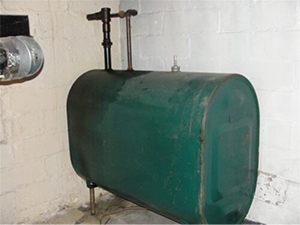
Photo 1: 275 Gallon Indoor Fuel tank
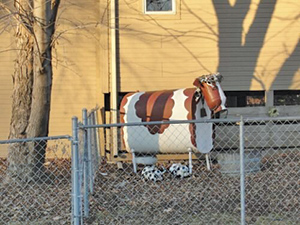
Photo 2: Outdoor Fuel Tank
Clues to a Buried Fuel Oil Tank
The easiest way to spot a potential buried fuel oil tank is to look for a fill pipe and vent pipe at the exterior of the home. Sometimes the pipes will go through the foundation wall of the home (Photo 3: Buried Fuel Oil Tank). Sometimes they just go down into the ground (Photo 4: Vent Pipe, Buried Tank, and Fill Pipe). When fuel oil tanks are removed, the fill and vent pipes need to be removed or cut off and filled with concrete. If you find pipes sticking out of the ground or foundation wall like the ones shown in Photo 4, it probably means one of two things: either the tank is still there, or it was removed by a hack. No professional fuel oil tank removal contractor is going to leave the vent and fill pipes looking like that. Why, you ask?
According to Dean Nething of Dean’s Tanks near Minneapolis, Minnesota, there were many “erroneous deliveries” that happened during the 60’s and 70’s, where one house address got confused with another and the oil was delivered to a home after the tank had been removed. About once a year, a basement would get contaminated with hundreds of gallons of fuel oil. In every one of these cases, the contamination was so bad that the fuel oil company, Standard Oil, had to buy the property so they could tear it down and dig out the basement. This is why the fill pipes always need to be removed when the tank is removed.
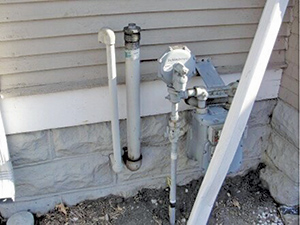
Photo 3: Buried Fuel Oil Tank
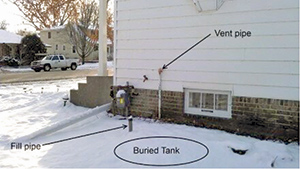
Photo 4: Vent Pipe, Buried Tank, and Fill Pipe
(story continues below)
(story continues)
When the pipes are right next to each other (Photo 4) there’s a good chance that the fuel oil tank is (or was) located inside or under the house. When the pipes are separated from each other, there’s probably a buried fuel oil tank in the yard. Photo 4 came from a house in Minneapolis, and these pipes led to a 1,000-gallon tank buried in the yard. I recall another scenario where the fill and vent pipes were located in the front yard behind some bushes at a home. These innocuous, nearly hidden pipes led to an enormous buried tank in the front yard. There was a subtle vent sticking up out of the ground behind some bushes that led to a buried fuel oil tank.
And finally, one of the most non-so-subtle clues that we have ever come across was a huge marked-up area on someone’s driveway (Photo 5: Buried Fuel Oil Tank Clue #2).
Tank Images
There are a few diagrams floating around online that show an indoor style of tank buried in the ground, like the big green one (Photo 1: 275 Gallon Indoor Fuel Tank). That type of indoor tank is extremely unusual to find buried, according to Dean’s Tank. The vast majority of buried tanks look a lot more like big drums (Photo 6: Big Drum Tank).
In another case when a fill pipe was sticking out of the ground, it had a cap that could be opened. I stuck my tape measure down the pipe, and it came out soaked in fuel oil. It smelled like fuel oil for the next two weeks, despite my efforts to clean it off. Fuel oil has a strong odor and takes a long time to go away. It’s easy to understand how a leaking tank can create such a nasty problem. The person buying this home had the sellers remove the tank and after it was removed you could no longer see the fill pipe.
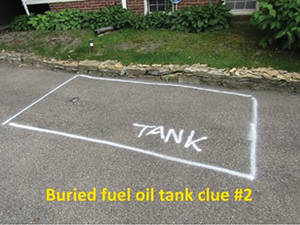
Photo 5: Buried Fuel Oil Tank Clue #2
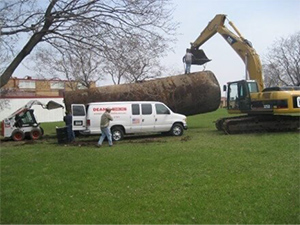
Photo 6: Big Drum Tank
What to Do if You Suspect a Buried Oil Tank
If you suspect a buried oil tank, call a company that specializes in fuel oil tanks to determine if a fuel oil tank is present.
If you want to confirm the presence of a buried tank quickly, before you call in the expert, one fast and simple way is put your ear to one of the pipes sticking out of the ground, then bang on the other with a hammer. If there’s a buried tank, you’ll be able to hear it; the sound will be really obvious because you’ll hear what sounds like a big, echo-y cavern.
The cost of removing a buried fuel oil tank varies greatly from property to property, but costs in the Minneapolis area typically range from $2,000 to $3,000. Having a tank filled in place has a comparable cost.
Buried Fuel Oil Tanks and Home Inspection Standards
Home Inspection Standards of Practice (SOP) specifically state that buried fuel oil tanks are not something that home inspectors are required to inspect. Here’s SOP language from the two largest home inspection organizations:
• ASHI: Inspectors are NOT required to inspect: underground items including, but not limited to underground storage tanks or other underground indications of their presence, whether abandoned or active.
• InterNACHI: The inspector is not required to inspect fuel tanks or underground or concealed fuel supply systems.
Does this mean that if a home inspector sees obvious clues that a buried fuel oil tank is present, they should keep their mouth shut? Heck no. A buried fuel oil tank is important to know about when buying a house. If a home inspector has enough experience to suspect a buried fuel tank, they should call for an expert to come out and take a look. While it’s not a requirement, this has become the standard of care for home inspections in many areas.
About the Author
Reuben Saltzman is a second-generation home inspector with a passion for his work, and is the owner and president of Structure Tech. Visit his blog online at: https://www.structuretech.com/blog/age-related-home-problems.
OREP/WRE Coronavirus Discussion and Resource Page
Coronavirus: National Home Inspector Survey
Free Risk Management Online Course Claims and Complaints: How to Stay Out of Trouble
Available Now
Presenter: David Brauner, Senior Insurance Broker OREP
David Brauner, Senior Broker at OREP, shares insights and advice gained over 25+ years of providing E&O insurance for inspectors, showing you how to protect yourself and your business. Watch Now!
Note: The Winter/Spring 2021 issue of Working RE Home Inspector is mailing now to over 25,000 home inspectors nationwide. OREP Insureds enjoy guaranteed delivery of each print magazine and many more benefits.


